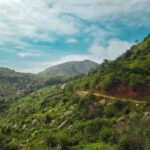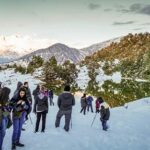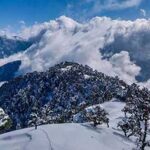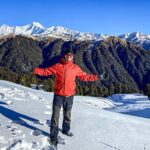
Hampta Pass trek is a popular monsoon trek after the Valley of Flowers, and thousands of trekkers venture on this adventure every year. Although the trek is known for its stunning views and thrilling experiences, every trekker wants to know the Hampta Pass Trek difficulty level before venturing on it.
Are you also among these trekkers? Worry not!
Knowing the difficulty level of a trek, particularly in monsoon season, is advantageous. The difficulty of the trek decides whether you will complete it or not. If you are aware of what to expect on a trek in advance, you can prepare accordingly and complete it.
Therefore, in this blog, I will help you analyse the Hampta Pass trek difficulty level based on various factors and answer some FAQs.
Overview of the Hampta Pass Trek
Before accessing the Hampta Pass Trek difficulty level, let us first explore the Hampa Pass trek.
Nestled in the stunning valleys of Kullu and Lahaul, the Hampta Pass Trek is among India’s most exciting pass-crossing treks. The trek starts from the picturesque Kulluy valley and ends in the deserted terrain of Lahual valley. In between, it takes you through dense forest, verdant meadows, and deep valleys with gushing rivers and makes you cross the iconic Hampta Pass at 14000 ft.
The overall length of the Hampta Pass trail is approx 25 Km, which you cover in 5 to 6 days with the following itinerary;
Day 1: Reach Manali early in the morning. Then drive from Manali to Jobra and trek to Jobra. You can camp at Jobra or trek further to Chika.
Day 2: Trek from Jobra or Chika to Balu Ka Ghera campsite.
Day 3: Trek from Balu Ka Ghera campsite to Hampta Pass. From Hampta Pass, trek down to Shea Goru campsite.
Day 4: Trek from Shea Goru to Chhatru campsite.
Day 5: Drive from Chhatru campsite to Manali.
Key Highlights and Attractions Along Hampta Pass Trek Route

1. Thrilling Drive In Sprawling Kullu Valley
On day one of the Hampta Pass trek, you take on a thrilling drive on a dirt track from Manali to Jobra.
The drive is full of adventure and scenic views of Kullu Valley, making you glued to the window of your car. In addition, you pass 42 hairpin bands while driving through the vibrant apple orchards, deodar and oak forest.
2. Action-Filled River Crossing
If you are looking for that extra thrill on this trek, it’s the river crossing you start doing from day 2.
You overpower strong and cold river currents to cross the streams using a human chain technique numerous times throughout the trek. It is these sections that add to the Hampta Pass trek difficulty level.
3. Exciting Pass Crossing
Another thrill on the Hampta Pass trek is the dramatic experience of crossing Hampta Pass.
On the third day of the trek, you climb towards the Hampta Pass through the gorge and cross three ledges before reaching the Hampta Pass. This section is full of snow and rocky terrain that questions your body’s endurance. Moreover, the 14000 ft altitude adds to the Hampta Pass trek difficulty level.
However, the view of Lahaul Valley from the other end point of the pass makes for hard work. It is a mesmerising view.
4. Picturesque Campsites

The best part of the Hampta Pass trek is the opportunity to camp beside gushing rivers in stunning landscapes. At all campsites, including Jobra, Chika, Balu Ka Ghera, Shea Goru, and Chattru, you pitch your tent on the banks of the river.
Imagine opening the zip of your tent with a view of the stunning river flowing in front of you. It is a lifetime experience.
5. Deserted Trerrain Of Lahaul Valley
Once you cross the Hampta Pass, you enter the deserted terrain of Lahaul valley. It is completely different from the terrain you have been experiencing till now. You see the barren mountains, with morain and scree sections all around and green patches of grass in between. It is a different setting in which you enjoy trekking.
6. Stunning Chandra Tal

On day 4 or 5, you can explore the charming Chandra Tal Lake. This 1 km-long lake is situated at an altitude of 4250m (13943.57 ft). It is known for its lovely setting and turquoise water. I suggest you do not miss this lake at any cost, except for bad weather.
What is the Hampta Pass Trek Difficulty Level?

If you want to know the difficulty level of any trek, there are four primary factors you need to consider.
- Gradient Of Trek
- Terrain Of Trek
- Highest Altitude On the Trek
- Accessibility Of an exit point
Let’s discuss them in detail to understand the Hampta Pass Trek difficulty level.
1. Gradient of Hampta Pass Trek
All the renowned trekking organisations in India consider the Hampta Pass trek to be a moderate-grade trek. There are numerous reasons for this.
First, the Hampta Pass trek duration is only 5 to 6 days, which is usual for any trek in the Himalayas. 5 to 6 days of trekking don’t put as much strain on your body as the longer duration treks like Pin Parvati Pass do.
Second, the Hampta Pass trek route is just 25 km long. Considering a Himalayan trek, covering 25 km is easier as you cover these km in multiple days. You cover approximately 3 km on day one, 9 km on day two, 7 km on day three, and 7 km on the fourth day.
Third, the weather on the Hampta Pass trek is not extreme like the Chadar Trek, where the temperature goes 40 degrees below zero. The weather on the Hampta Pass trek from June to September is usually pretty good, with a few showers of rain.
Hampta Pass in June has windy days and colder nights. In July and August, it rains more, but weather is warmer compared to June. Then again, in September the cold weather starts to set in.
So, due to its moderate duration, length, and weather, the Hampta Pass Trek difficulty level is considered easy to moderate by the majority of trekking organisations and trekkers.
2. Terrain Of Hampta Pass Trek
On the Hampta Pass trek, you are exposed to two completely different terrains: Kullu Valley and Lahaul Valley. The terrain of these two valleys defines the Hampta Pass Trek difficulty level.
You start the trek in Kullu valley, inside the dense oak and deodar forest, with an easy trail. Here, you have lots of oxygen to breathe, away from the scorching sun. This makes it pretty easy to cover more distance in less time.
Trekking further in coming days, you leave behind the treeline and walk in valleys with lush green meadows and gushing rivers. Crossing these rivers is a bit tricky but thrilling. As discussed earlier, you use the human chain technique to overcome the strong river current.
Further, on day three, when you trek from Balu Ka Ghera to Hampta Pass, you walk through rocky terrain and climb to Hampta Pass, which is full of snow. This section is also tricky and demands you to exert a lot of physical effort. In fact, this is the most difficult section of the Hampta Pass trek.
Once you cross the Hampta Pass, you encounter completely different terrain. Now, you have rocky mountains with moraine and scree patches all around. Though the terrain looks rough, the trail down through the valley is moderately difficult to pass.
By now, you must have an idea that the terrain of the Hampta Pass trek is relatively easy. In fact, you can trek comfortably through it with good support and planning. However, heavy rain and snow can increase the Hampta Pass trek difficulty level, but its rare if you plan your trek from June to September.
3. Highest Altitude On Hampta Pass Trek
On the Hampta Pass trek, it’s not about the highest altitude you touch but the quick gain in altitude. During a span of just three days, you reach 14000 ft at Hampta Pass.
It all starts on day one from Manali, which is at 6000 ft. On the same day, you climb to reach Jobra and Chika campsites, which are at 9000 ft and 10,000 ft, respectively. Then, on day two, you climb another 3000 ft to reach Balu Ka Gehra campsite. From here, the next day, you climb to Hampta Pass, which is at 14000ft.
Such a quick gain in altitude makes you susceptible to Altitude sickness, which can be dangerous if not managed properly. For this reason, you are advised to trek with reputed organisations like Trek The Himalayas, India Hikes, and Bikat Adventures, who are experts in handling such emergency situations. In addition, you should also be aware of altitude sickness and how to handle it.
In the end, quick altitude gain is the only factor, compared to other factors, that increases the Hampta Pass trek difficulty level.
4. Accessibility Of an exit point on Hampta Pass Trek
What do you think about exit points on the trek? Why are they needed?
The role of exit points in any trek is to help you make an emergency exit.
On the Hampta Pass trek, there is no exit point between the Balu Ka Ghera campsite and Shea Goru campsite. Between these points, the only way to exit is to go back to basecamp or cross Shea Goru to reach Chattru, the nearest road head.
This makes it tricky to pass these sections, and therefore, you must pay close attention to yourself to keep safe from getting AMS or ill.
In light of all these factors, you can conclude that the Hampta Pass trek difficulty level is moderate. Nevertheless, you must consider and prepare well for a few factors, such as tricky pass crossing and quick altitude gain.
FAQ about Hampta Pass Trek Difficulty Level
Is Hampta Pass Trek good for beginners?
Yes. The Hampta Pass trek is perfect for beginners due to its beginner-friendly terrain, moderate gradient and length, and 5-day duration. But before venturing on the trek, ensure you prepare well and make yourself physically and mentally fit.
Is Hampta Pass risky?
No, if you are fit and choose an experienced trekking organisation with high safety standards. However, neglecting these factors can be risky.
Is Hampta Pass steep?
Climbing the iconic pass is one section of the Hampta Pass trek that is steep. This section tests your fitness level.
Can I do Hampta Pass solo?
Yes, if you are an experienced trekker who has done multiple treks in the Himalayas. But still, it is advised that you must take a local guide with you to be on the safer side.
Is Hampta Pass a monsoon trek?
Yes, the Hampta Pass trek is one of the best monsoon treks in Himachal Pradesh, and it can be done from June to September.
Which month is best for Hampta Pass?
The best time to do the Hampta Pass trek is from mid-July to the end of August. During this time, the grasslands are lush green, and the whole terrain is booming with colorful wild flowers.
Can Hampta Pass be done without a guide?
No. You must take an experienced guide to complete the trek and avoid unnecessary incidents or emergencies.
Is Hampta Pass a high-altitude trek?
Yes. Hampta Pass is a high altitude trek with a highest altitude of 14000 ft, which you gain quickly within three days.
Is the Hampta Pass trek safe in July?
Yes. Trekking the Hampta Pass in July is safe, as the snow has already melted, and the slopes are sprawling with colourful flowers. All the routes are open and safe.
Do we need permission to go on the Hampta Pass trek?
Yes. You must get permission from the forest department before venturing on the trek.
Is Hampta Pass a snow trek?
No. The season for the Hampta Pass trek is from June to September, and during these months, you won’t find any snow on the trek except a few patches in June.
Final Words
Hampta Pass trek is a splendid monsoon trek with numerous attractions, such as river crossing, high-altitude pass crossing, camping beside gushing rivers, and a trek inside Lahaul Valley. It is a perfect opportunity for all trekkers to get a taste of vibrant Himalayan valleys in the monsoon.
Although the trek is considered moderate among the trekking fraternity, factors such as quick altitude gain and steep pass climbing increase the difficulty level of the Hampta Pass trek. However, if you prepare well and choose a reliable trekking partner, you can easily overcome these obstacles.
So, what are you waiting for? Start preparing yourself for an unforgettable adventure on the Hampta Pass trek.
Moreover, if you have any questions, please drop them in the comment section below.







